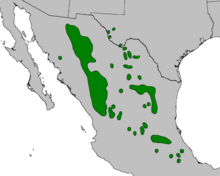Pinus cembroides
| Pinus cembroides | |
|---|---|
 |
|
| Mexican pinyon in Big Bend National Park, Texas | |
| Scientific classification | |
| Kingdom: | Plantae |
| Division: | Pinophyta |
| Class: | Pinopsida |
| Order: | Pinales |
| Family: | Pinaceae |
| Genus: | Pinus |
| Subgenus: | Ducampopinus |
| Species: | P. cembroides |
| Binomial name | |
|
Pinus cembroides Zucc. |
|
 |
|
| Natural range | |
| Synonyms | |
|
|
Pinus cembroides, also known as pinyon pine,Mexican pinyon,Mexican nut pine, and Mexican stone pine, is a pine in the pinyon pine group, native to western North America. It grows in areas with low levels of rainfall and its range extends southwards from Arizona, Texas and New Mexico in the United States into Mexico. It typically grows at altitudes between 1,600 and 2,400 metres (5,200 and 7,900 ft). It is a small pine growing to about 20 m (66 ft) with a trunk diameter of up to 50 cm (20 in). The seeds are large and form part of the diet of the Mexican jay and Abert's squirrel. They are also collected for human consumption, being the most widely used pine nut in Mexico. This is a common pine with a wide range and the International Union for Conservation of Nature has rated its conservation status as being of "least concern".
The range extends from westernmost Texas, United States (where it is restricted to the Chisos and Davis Mountains), south through much of Mexico, occurring widely along the Sierra Madre Oriental and Sierra Madre Occidental ranges, and more rarely in the eastern Eje Volcánico Transversal range. It lives in areas with little rainfall, which fluctuates between 380 millimetres (15 in) to 640 millimetres (25 in), the subspecies orizabensis (Pinus orizabensis) is found farther south in the state of Veracruz. There is also a disjunct population in the Sierra de la Laguna of southern Baja California Sur. It occurs at moderate altitudes, mostly from 1,600 metres (5,200 ft) to 2,400 metres (7,900 ft).
...
Wikipedia

